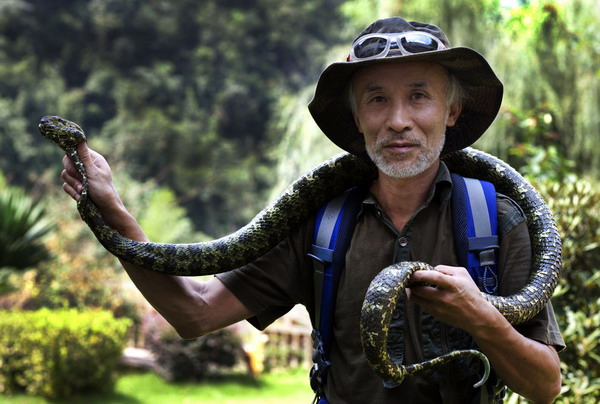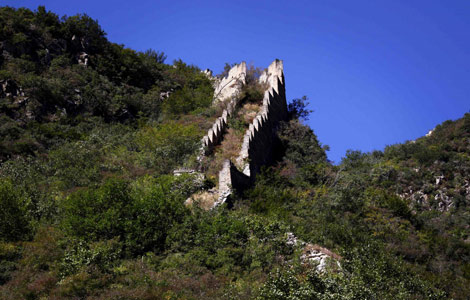'Dr Snake' bears fangs for conservation
Updated: 2011-02-17 08:02
By Duan Yan (China Daily)
|
|||||||||||
|
 Chen Yuanhui - aka 'Dr Snake' - poses in this 2010 file photo with a wild venomous Mangshan pit viper, an endangered species he discovered in 1989 and one he has worked to protect ever since. [Photo/for China Daily]
|
| ||||
He has become known as "Dr Snake" in his community in mountainous Mangshan, in Central China's Hunan province, the place from which his Mangshan pit viper takes its appellation.
A statue of him with one of the serpents slithering over his shoulders stands at the gate of the Mangshan Museum of Natural History, where Chen works as the curator. The monument was donated by local businesspeople in 2008 as a tribute to his work.
"I hadn't heard of the snake until 1984," Chen said.
That was the year he was working at the staff hospital of the Mangshan Forestry Administrative Bureau when an elderly snakebite patient described an ophidian variety unlike anything Chen had seen.
The patient said the creature had green-and-yellow markings and a white tail.
It reminded Chen of the local Yao ethnic group's venerated totem - the "small, green dragon" - and he set out to hunt for the species.
In October 1989, he heard some people had captured a nest of 23 snakes. He went to investigate and discovered the creatures fit the description given by the old man years before.
He took the specimens to herpetologist Zhao Ermi, and, by 1990, the species was confirmed to have been previously undiscovered and endemic to the country.
Chen began researching the creatures and kept seven specimens in his home.
He spoke of them as if they were his children.
"The snakes are very lazy," he said. "Most of the time they just lay in the cage and don't move until later in the afternoon. When they're hungry, they tap against the walls to make noise."
The sounds of the creatures and odor of their feces upset his wife and daughter for years and caused family disputes. Still, his family members were his biggest supporters, he said.
"My wife used to call me a 'cold-blooded animal, just like the snakes'," he recalled, tearing up at the thought of the woman, who passed away in 2006.
Chen has survived nine bites over the past three decades. The last one, which he captured on film, nearly cost him his life - and did cost him a finger - in 2003.
There are between 300 and 500 Mangshan pit vipers in the wild, and the species was included on the International Union for Conservation of Nature's Red List of Threatened Species in 1996. Their numbers are fewer than the giant pandas', earning it the nickname "the panda of snakes".
However, the reptile - regarded by many in herpetological circles as "the most beautiful of snakes" - is not included on the List of National Key Protected Wild Animals in China.
Consequently, there are no severe punishments for hunting the wild creatures.
Chen said he has rejected countless offers from hopeful buyers.
"If I started selling snakes, the villagers would follow my lead and catch snakes on the mountains," he said.
"It wouldn't take long for the species to disappear from the wild."
Smugglers offer 6,000 yuan ($910) to 7,600 yuan per kilogram for Mangshan pit vipers.
"Many villagers have the snake smugglers' contact numbers the money is much more than what they could earn growing crops in a year," Chen said.
About 80 forest rangers keep poachers away from the MangshanNational Nature Reserve. But smugglers still enter the snakes' habitat through the other side of Hunan's border with northern Guangdong province, Chen said.
The buyers are not just reptile lovers but also research institutions and zoos, Chen said.
Smuggling of the snakes to such overseas destinations as the United States and Germany has also become rampant, Chen added.
The Mangshan Forestry Administrative Bureau founded, and made Chen chief of a Mangshan pit viper institute in 2008.
"I've never been a full-time researcher," Chen said, joking that his study of the pit viper is more like a hobby.
But raising public awareness about the importance of protecting snakes has become more like a mission, one he sustains through his blog.
"After all,I am the only researcher of the Mangshan pit viper in its natural habitat," Chen said.
He plans to open a small outdoor area in the forest for research and for tourists to see the creatures in their natural habitat.
"Glass rooms are not good for the snakes. They should live in the wild," he said.
He recalled that a burglar broke the door of an observation station in the museum and stole one of the pit vipers in 2005.
"When the snakes can hide between stones, they'll be more difficult for thieves to catch," he said.












